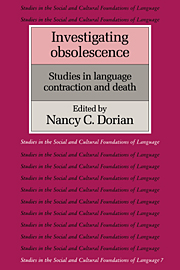Book contents
- Frontmatter
- Contents
- List of maps
- List of contributors
- Preface
- Map
- Dedication
- Introduction
- I Focus on context
- II Focus on structure
- III Invited commentaries
- 21 Some people who don't talk right: Universal and particular in child language, aphasia, and language obsolescence
- 22 Language obsolescence and language history: Matters of linearity, leveling, loss, and the like
- 23 Language convergence and language death as social processes
- 24 Pidgins, creoles, immigrant and dying languages
- 25 The “up” and “down” staircase in secondary language development
- Bibliography
- Index of languages
- General index
24 - Pidgins, creoles, immigrant and dying languages
Published online by Cambridge University Press: 08 January 2010
- Frontmatter
- Contents
- List of maps
- List of contributors
- Preface
- Map
- Dedication
- Introduction
- I Focus on context
- II Focus on structure
- III Invited commentaries
- 21 Some people who don't talk right: Universal and particular in child language, aphasia, and language obsolescence
- 22 Language obsolescence and language history: Matters of linearity, leveling, loss, and the like
- 23 Language convergence and language death as social processes
- 24 Pidgins, creoles, immigrant and dying languages
- 25 The “up” and “down” staircase in secondary language development
- Bibliography
- Index of languages
- General index
Summary
In dealing with the similarities and differences between dying languages, pidgins, creoles, and immigrant languages, I will concentrate my remarks on two areas: the nature of the sociolinguistic context which gives rise to these varieties of language, and structural factors common to these cases. Finally, I will draw some conclusions about the implications of the study of these languages for linguistic theory and suggest some directions for further research.
In attempting to sketch a sociolinguistic profile of the context in which pidgins, creoles, dying, and immigrant languages emerge, the most general factor that can be mentioned is that of language contact. Seuren (1984:209) says that whatever is universal in creoles is also characteristic of contact languages of any kind that get turned into native languages. Even leaving aside the question of how much nativization owes to universals, at the moment there is not enough systematic descriptive and theoretical work in language contact to draw up a typology of parameters from the relevant cases. This collection is a particularly useful beginning.
I will not single out immigrant languages as a special case because immigrant languages may of course be as healthy as varieties of these languages spoken elsewhere. Typically, however, for a variety of political and social reasons, which many of the contributors here discuss in detail, they aren't. The fact that healthier varieties of these languages exist elsewhere for comparison is in many ways a methodological advantage. Another, on occasion, is the existence of a range of communities using a restricted variety for different purposes (see, for example, Huffines on Pennsylvania German, Mithun on Cayuga, also Hamp 1978 and this volume).
- Type
- Chapter
- Information
- Investigating ObsolescenceStudies in Language Contraction and Death, pp. 369 - 384Publisher: Cambridge University PressPrint publication year: 1989
- 17
- Cited by

